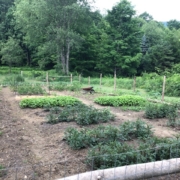Turning a Patch of Lawn into a Vegetable Garden, Part 4
I’m working on a piece about soil fertility for Volume II of the Almanac, and part of my background research involves reading a book the late Jack Lazor wrote on grain growing. Lazor broke soil fertility down into three interdependent realms: the chemical, the physical, and the biological. And he made the point that conventional agriculture can be exploitive and short sighted when farmers just focus on the chemical. Through Lazor’s organic lens, soil is an ecosystem where billions of microorganisms “work in conjunction with a soil’s mineral and humus factions to feed themselves and the plants that grow there.” High levels of organic matter mean happy microbes and happy plants, and so growers use compost and cover crops and manures to grow soil before they grow plants. In a conventional system, farmers just add chemical nutrients from a bag, and without mitigation measures, the organic matter in this soil is depleted.
Farmers transitioned away from organic practices for financial reasons. And in theory, us home gardeners have the luxury of being able to do better because we don’t have a profit motive. And yet it’s so hard, even for us, to escape the chemical mindset; the allure of magic in a bag as opposed to the hard work of incorporating three yards of compost with a shovel and pitchfork.
I think part of the problem here is that we’ve been conditioned to see fertilization as an act of care. We’re feeding our plants from the bag. And chemical fertilizer works. If you go out and sidedress your plants with some Scott’s 10-10-10 this week, and we get adequate rain, they’re going to pop. Lazor points out that the soil carbon is burned up in the process of converting the fertilizer to Nitrogen, and over time soil is hardened by modern fertilizer. But this is a problem years in the making, as opposed to results that are immediate and easy to see. And if one plant food takes seconds to apply, and the other hours and days, then why not push the easy button?
I think a better way to get through to home gardeners about the benefits of organic amendments is to highlight the way organic soils hold water. In my experience, water retention, not fertility, is the miracle of compost. That’s the reason to do the hard work. For every one percent increase in organic matter, an acre of soil will retain an additional 160,000 gallons of water. And as the climate changes and weather gets more extreme, home gardeners are going to be dealing with dry conditions more and more. It’s easier to get nitrogen from a bag than from compost, but it’s easier to mix in compost once a year than it is to lug a watering can around to every plant all summer.
I laid out this garden with a center hallway, then used a broadfork and hand tiller to elevate beds. (Because this was a lawn that’s been mowed for decades with a riding mower, it’s pretty heavily compacted.) I borrowed a truck trailer and bought 2.8 yards of compost, which I incorporated into the top layer of the beds. That’s all I did to make the beds. I didn’t raise them because I want the plants to be able to work their roots down into the cool reservoir of the earth. As I add compost each year, they will naturally raise themselves.
So far this year it’s been relatively dry. And I’ve done no supplemental watering. Still, the dirt’s inherent 4.6 percent organic content (this figure from the initial soil test) and the compost I added have allowed the plants to take hold and take off.


